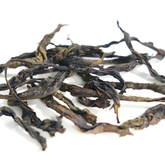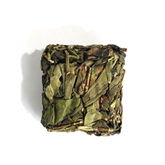Is Green Tea Fermented? The Science Behind Its Fresh, Grassy Flavor
Many foreign tea lovers often ask me: “Is green tea fermented?” This seemingly simple question actually reflects the East-West divide in understanding “fermentation” vs. oxidation. As a tea specialist, I’ve met many newcomers to Chinese tea who think all teas are fermented like black tea or pu-erh. Some even asked in shock: “If green tea isn’t fermented, is it just raw leaves?” According to a 2022 survey by the International Tea Institute (ITI): 73% of Western consumers mistakenly believe green tea is fermented. In reality, as Professor Liu Zhonghua from the Chinese Academy of Agricultural Sciences explains: “Green tea’s defining process is de-enzyming (sha qing). It’s like hitting the pause button on oxidation, which is why green tea is non-fermented.”
According to a 2022 survey by the International Tea Institute (ITI): 73% of Western consumers mistakenly believe green tea is fermented. In reality, as Professor Liu Zhonghua from the Chinese Academy of Agricultural Sciences explains: “Green tea’s defining process is de-enzyming (sha qing). It’s like hitting the pause button on oxidation, which is why green tea is non-fermented.”
What is tea “fermentation”?
Many foreign friends learning about Chinese tea confuse “fermentation” and “oxidation.” In reality, these processes work very differently in tea production. A few years ago, I demonstrated tea-making techniques to a European client. When he saw black tea turn dark while green tea stayed vibrant, he gasped: “Isn’t this all caused by fermentation?” I explained with a smile: Black tea’s color comes from enzymatic oxidation, while true “fermentation” involves microorganisms—like in yogurt, kimchi, or wine.
A few years ago, I demonstrated tea-making techniques to a European client. When he saw black tea turn dark while green tea stayed vibrant, he gasped: “Isn’t this all caused by fermentation?” I explained with a smile: Black tea’s color comes from enzymatic oxidation, while true “fermentation” involves microorganisms—like in yogurt, kimchi, or wine.
In tea, “fermentation” mainly refers to oxidation of the leaves’ natural compounds, not microbial activity. As Professor Zhuang Wanfang, a renowned Chinese tea scientist, clarified: “Tea ‘fermentation’ is an enzyme-driven reaction within the leaf itself.” This explains why black tea is fully oxidized, while green tea uses de-enzyming (sha qing) to halt oxidation and preserve its fresh, natural flavor.
So when we ask “Is green tea fermented?”—the answer lies in understanding that its oxidation process is intentionally stopped.
| Aspect | Common Western Fermentation | Tea "Fermentation" |
|---|---|---|
| What's Needed | Microbes (yeast/bacteria) | Tea leaf's own enzymes |
| Conditions | Damp & sealed | Controlled warmth & airflow |
| Examples | Wine, beer, sauerkraut, yogurt | Black tea, oolong tea |
| Time | Days to years | 2-8 hours (tea) |
| End Result | Alcohol, sour taste, bubbles | Leaves turn red, floral/fruity smells |
| Can You Stop It? | Only by killing microbes (e.g. pasteurization) | Yes! Heat stops enzymes (e.g. green tea "kill-green" step) |
How is Green Tea Made?
The key to green tea production lies in stopping oxidation (halting enzymatic reactions) through physical methods. A high-heat treatment (like pan-firing or steaming) quickly deactivates the tea leaves’ oxidizing enzymes, preventing polyphenols from oxidizing. This preserves the tea’s vibrant green color and fresh, crisp flavor. Next, the leaves are rolled to shape them and release their natural juices, then dried to remove moisture and stabilize quality. No fermentation occurs at any stage.
Next, the leaves are rolled to shape them and release their natural juices, then dried to remove moisture and stabilize quality. No fermentation occurs at any stage.
In contrast, other teas (like oolong or black tea) undergo hours of enzymatic oxidation during their withering phase. This is why green tea is classified as non-fermented—its oxidation process is entirely blocked.
Green Tea Processing Steps
| Processing Step | Method | Key Parameters | Main Purpose | Impact on Quality |
|---|---|---|---|---|
| De-enzyming (Sha Qing) | High-heat treatment (steam, hot pan, or drum) | 180-220°C, 1-3 minutes | Destroy enzymes to stop oxidation, retain green color | Softens leaves, removes grassy smell, unlocks fresh aroma |
| Rolling | Mechanical pressing or hand-rolling | Pressure: 5-15 kg, 20-40 minutes | Shape leaves, release tea sap, blend flavors | Enhances tea thickness, sheds fine hairs, tightens leaf shape |
| Drying | Oven-drying, pan-frying, or sun-drying | 60-100°C, moisture ≤5-7% | Stop chemical changes, lock in quality, prevent spoilage | Fixes aroma (nutty, floral), reduces bitterness |
Fermentation Levels of China’s Six Major Tea Categories
The core difference among China’s six major tea categories lies in their fermentation levels (oxidation). During processing, controlling the oxidation degree of tea leaves shapes their distinct flavors. For example, white tea relies solely on natural withering to mildly activate enzymatic activity, with minimal human intervention, creating its mellow and sweet taste; black tea involves fully crushing the tea leaves during processing, allowing enzymes and polyphenols to react completely and generate thearubigins (red pigments). Below are the fermentation levels of the six major tea categories, along with their classic Chinese representatives:
6 Major Tea Types by Fermentation Level
| Tea Type | Fermentation Type | Fermentation Level | Popular Examples | Flavor Profile |
|---|---|---|---|---|
| Green | Non-fermented | 0-3% | Longjing, Biluochun | Fresh grass, seaweed, chestnut notes |
| White | Light (Natural Oxidation) | 5-10% | Silver Needle, Shou Mei | Honey, dried fruit, herbal notes |
| Yellow | Gentle (Warm & Moist) | 10-20% | Junshan Yinzhen | Toasted rice, sweet corn silk |
| Oolong | Partial (Enzyme-Activated) | 15-70% | Tieguanyin, Da Hong Pao | Orchid, ripe peach, roasted nuts |
| Black | Full (Enzyme-Driven) | 80-95% | Keemun, Lapsang Souchong | Malt, dark chocolate, smoked wood |
| Dark | Post-Fermented (Microbes) | 100%+ | Pu'er, Anhua Dark | Earthy, aged wood, dried dates |
Data sources: ISO 11287 Tea Standards, Specialty Tea Institute (USA)
Quick Answers to Common Green Tea Questions
1. Does Arizona Green Tea have caffeine?
Yes, but less than coffee. A 16oz can has about 15-20mg caffeine (1/4 of coffee). Decaf versions exist.
2. How long to steep green tea?
1-3 minutes in 160-180°F water. Japanese greens (like sencha) need 1 min, Chinese greens (like Dragonwell) up to 3 mins. Oversteeping → bitterness.
3. Does green tea stain teeth?
Minimal risk. Green tea has 1/3 the tannins of black tea. To prevent: rinse mouth after drinking, use straw.
4. Does green tea expire?
Best within 6-12 months. Store airtight in dark, cool place. Old tea loses freshness but is safe to drink.
5. Is green tea the same as matcha?
No. Matcha is powdered shade-grown green tea with 3x more caffeine. Regular green tea uses whole/cut leaves.
SEE MORE CHINESE TEAS
If you have questions about selecting tea:
Learn-more-about-chinese-tea
If you have questions about the benefits of tea:
Health-benefits-of-chinese-tea
If you have questions about brewing tea:
How-to-brew-loose-leaf-tea






